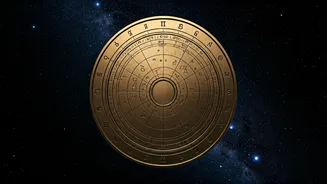Ancient Beginnings of Astrology
Astrology's roots trace back to ancient civilizations, including Mesopotamia, Egypt, and Greece. Mesopotamian astrology, developed around the 2nd millennium
BC, was one of the earliest known forms, focusing on observing celestial events and divining their meaning for rulers and the state. Egyptian astrology, similarly, involved the observation of celestial movements and their interpretations in determining individuals' destinies. The Greeks, integrating Mesopotamian and Egyptian concepts, further developed astrological systems. They incorporated philosophical ideas and developed complex astrological models. The Hellenistic period witnessed the emergence of birth chart astrology, which charted the positions of celestial bodies at the moment of a person's birth, setting the foundation for many astrological practices still used today. This early interplay of observation, interpretation, and philosophical thought shaped the evolution of astrology into what it is today.
Core Principles Explained
At the heart of astrology lies the belief that the positions of celestial bodies—namely the Sun, Moon, planets, and constellations—at the time of a person's birth (or other significant events) can influence their personality traits, behaviors, and life experiences. Astrologers use birth charts, or natal charts, as a primary tool to understand individuals. A birth chart is a map of the sky at a specific moment in time and is calculated based on the person's birth date, time, and location. This chart displays the positions of the planets within the zodiac signs and houses, the various sectors that represent different areas of life. Planetary positions within the zodiac signs provide insights into how a planet's energy manifests. For instance, the Sun in Leo might signify a person's creativity and leadership qualities, while the Moon in Cancer could suggest emotional sensitivity. Astrologers consider aspects, or the angles formed between planets in a chart, to reveal how different planetary energies interact. These aspects, such as conjunctions, oppositions, and trines, highlight potential strengths, challenges, and areas of harmony or conflict in a person's life. The interpretation of these elements is a core process in astrological practice.
Zodiac Signs and Meanings
The zodiac, a belt of constellations through which the Sun, Moon, and planets appear to move, is a cornerstone of astrology. The zodiac is divided into twelve segments, each corresponding to a specific sign, like Aries, Taurus, Gemini, etc. Each sign has its own unique characteristics, associated elements (fire, earth, air, water), and ruling planets. Aries, the first sign, is often associated with energy, action, and initiative, ruled by Mars. Taurus, an earth sign, is associated with stability and sensuality, under the rule of Venus. Gemini, an air sign, is known for communication and adaptability, ruled by Mercury. Cancer, a water sign, is associated with emotions and nurturing, ruled by the Moon. Leo, a fire sign, is known for creativity and leadership, ruled by the Sun. Virgo, an earth sign, is associated with practicality and analytical skills, ruled by Mercury. Libra, an air sign, is known for balance and harmony, ruled by Venus. Scorpio, a water sign, is associated with intensity and transformation, ruled by Pluto and Mars. Sagittarius, a fire sign, is known for optimism and adventure, ruled by Jupiter. Capricorn, an earth sign, is associated with discipline and ambition, ruled by Saturn. Aquarius, an air sign, is known for innovation and independence, ruled by Uranus and Saturn. Pisces, a water sign, is known for compassion and intuition, ruled by Neptune and Jupiter. Astrologers interpret these signs in the context of the planets and houses to create a comprehensive personality profile and predictive reading.
Planets in Astrology
In astrology, each planet represents different aspects of our personality and life experiences. The Sun, representing our core identity and ego, highlights our fundamental purpose and life direction. The Moon reflects our emotions, intuition, and inner self, showing how we react and feel. Mercury, the planet of communication and intellect, influences our thinking processes, how we communicate, and how we learn. Venus, the planet of love and beauty, governs our relationships, values, and aesthetic preferences. Mars, representing action and drive, dictates our assertiveness, energy levels, and how we pursue our goals. Jupiter, the planet of expansion and abundance, is associated with luck, optimism, and growth, highlighting opportunities for personal and spiritual development. Saturn, the planet of structure and responsibility, signifies discipline, limitations, and the lessons we learn through challenges. Uranus is associated with change, innovation, and unpredictability, bringing about sudden events and breakthroughs. Neptune represents dreams, spirituality, and illusions, inspiring creativity but also potential for deception and confusion. Pluto signifies transformation, power, and rebirth, prompting deep-seated changes in our lives. Astrologers analyze the placement of these planets in the signs and houses of a birth chart to gain a deeper understanding of an individual's characteristics and potential life paths.
Houses and Life Areas
Astrology employs the concept of houses to delineate different spheres of life. The birth chart is divided into twelve houses, each corresponding to a specific area of experience. The First House is associated with identity and self-image, reflecting how we present ourselves to the world. The Second House concerns our values and material possessions, touching upon money and resources. The Third House relates to communication, learning, and local environment. The Fourth House symbolizes home, family, and emotional foundations. The Fifth House covers creativity, pleasure, and romance, representing our self-expression and hobbies. The Sixth House is associated with work, health, and daily routines, representing our responsibilities and how we manage our health. The Seventh House pertains to relationships and partnerships, indicating significant connections with others. The Eighth House covers transformation, shared resources, and deeper emotional connections. The Ninth House relates to higher education, travel, and beliefs. The Tenth House symbolizes career and public life, highlighting our ambitions and achievements. The Eleventh House is linked to friendships, groups, and social circles. Finally, the Twelfth House encompasses the subconscious, spirituality, and hidden aspects of the self. Planets within each house, along with the signs on the house cusps, add layers of depth to the chart interpretation.
Astrology's Scientific Standing
The scientific community generally views astrology with skepticism due to the lack of empirical evidence supporting its claims. A primary criticism is the absence of controlled studies that validate astrology's predictive accuracy. One of the fundamental challenges for astrology lies in the reproducibility of its interpretations and the subjective nature of astrological readings. Critics argue that astrological interpretations are often vague enough to fit a wide range of individuals, leading to a phenomenon known as the Barnum effect. Another significant critique involves the lack of a plausible mechanism for how celestial bodies could influence human affairs. The gravitational and electromagnetic forces exerted by planets are considered too weak to significantly impact human lives, especially at the distances involved. Furthermore, the statistical tests that have been done on astrological predictions have yielded inconsistent and often negative results. While some individuals find astrology helpful for self-reflection and personal growth, the scientific community emphasizes the importance of evidence-based practices and rigorous testing to assess the validity of any claim.
Modern Astrological Practices
Today, astrology is practiced globally, evolving through various traditions and adapting to contemporary society. Many astrologers offer personalized birth chart readings, relationship compatibility analysis, and forecasts for the future. These services are accessed through in-person consultations, online platforms, and mobile applications. Different types of astrology have developed, with Western astrology, the most commonly known, utilizing the tropical zodiac and focusing on the seasons. Vedic astrology, originating in India, uses the sidereal zodiac and places emphasis on the lunar cycles and planetary periods (Dashas). Chinese astrology bases its system on the lunar calendar, integrating the five elements (wood, fire, earth, metal, water) and the twelve animal signs. These modern practices also often incorporate psychological insights, combining astrology with psychology to offer deeper self-awareness. Despite these developments, astrology remains a topic of considerable discussion. It balances its historical roots with modern influences, continuing to attract followers and critics worldwide.















